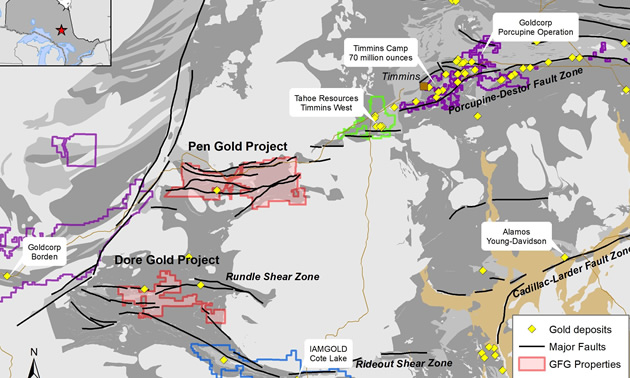GFG begins drilling at its Pen Gold Project west of Timmins, Ontario

Location of Pen & Dore Gold Projects in Ontario, Canada. — Photo courtesy GFG Resources Inc.
GFG Resources Inc. (TSX-V: GFG) (OTCQB: GFGSF) (“GFG” or the “Company”) is pleased to announce that drilling has started at its 100% owned Pen Gold Project located within the western portion of the Abitibi greenstone belt west of Timmins, Ontario, Canada.
Key Highlights:
- Objective of the Phase 1 drill program is to drill test approximately 15 priority targets distributed across a 20-kilometre segment in the eastern portion of the Pen Gold Project;
- The Phase 1 drill program will consist of 5,000 to 6,000 metres in 25 to 30 holes ranging in depth from 150 to 300 metres;
- Drilling has commenced at the eastern extent of the Deerfoot regional target and will sequentially test targets in the Jehann and Reeves regions;
- The drill program will test newly generated targets from the integration of geological, geochemical, structural and geophysical datasets that were recently completed as well as infill and follow-up of relevant historic drill intercepts; and
- In conjunction with the drill program, the Company continues to progress towards completing its Phase 2 till sampling program and an extensive IP survey of the Reeves regional target area and advancing other priority regional targets across the property.
“Following months of hard work we are very excited to begin the Phase 1 drill program at our recently acquired Pen Gold Project,” said Brian Skanderbeg, GFG’s president and CEO. “With the use of modern technology and integration of historic data at a district scale, our technical team demonstrated that this area is highly prospective and has identified numerous high priority targets. Our focus during this Phase 1 drill program will be on three camp scale targets that have the potential to yield multiple gold discoveries.”
Mr. Skanderbeg added, “This is an exciting time for the Company as we advance two drill programs with the opportunity to make a new discovery at both our Ontario and Wyoming projects. We are confident in our people, projects and the opportunity to unlock significant value through discovery.”
2018 Program Outline
Deerfoot
The Deerfoot regional target contains the interpreted westward extension of the Porcupine-Destor Fault Zone (“PDFZ”) and associated second-order fault splays that dissect Abitibi Greenstone belt stratigraphy. The stratigraphy, structure and nature of mineralization are analogous to that which hosts the Timmins West, Thunder Creek and the 144 Gap deposits currently being mined or developed by Tahoe Resources 15 kilometres to the northeast. This year GFG completed high-resolution airborne magnetics and detailed ground-based IP surveying to better constrain lithology and structure, and to trace mineralized structures in an area of extensive till cover that has hindered historic prospecting efforts.
In the eastern part of the Deerfoot target, three to four holes will focus on testing extensions to the Sewell occurrence that returned historic drill intercepts up to 60.0 grams of gold per tonne (“g/t Au”) over 1.3 metres (“m”) in shear-hosted quartz veining cutting syenite and diorite. Confirmation sampling of the outcropping pyrite-bearing quartz vein at Sewell in 2018 confirms the high-grade nature of this zone with surface grab samples returning gold grades of 11.5, 20.4, 77.0 and 399.4 g/t. Gold mineralization is open to the west and at depth to the north.
The Company will also test six new targets that have been identified in the eastern Deerfoot region. These targets were generated and refined from new structural interpretation of magnetics and results from 3D inversion of IP data. High-priority targets are defined by chargeability anomalies that occur on ‘breaks’ in magnetic features and/or on the flank of resistive bodies that occur along mineralized structures. Highly anomalous pristine gold grains recovered from a regional till sample directly down-ice (to the south) of these untested targets provides further support of the local prospectivity.
In the central part of Deerfoot region, the Company will complete follow-up and step-out holes at the HGM occurrence where historic drill assays returned up to 43.0 g/t Au over 1.5 m in sulphidized carbonate-altered mafic volcanic rocks within a shear zone. Gold mineralization is open to the west and at depth to the north. One to two drill holes have been allocated to test for possible extensions of the system.
Approximately 500 metres to the west of the HGM occurrence, widely-spaced historic drill holes intersected significant near-surface gold mineralization along the same structure however no follow-up drilling has been completed to date. Historic intercepts include 21.0 g/t Au over 1.3 m in quartz veining at the contact between ultramafic and carbonate-altered mafic volcanic rocks; and 4.0 g/t Au over 0.8 m in pyrite-bearing ultramafic rocks. This segment of the mineralized structure is characterized by a complex magnetic pattern which may relate to lithologic variation and competency contrasts that can localize gold mineralization. This area will be tested with three to four drill holes during the 2018 program.
Reeves
The Reeves regional target in the central portion of the property is characterized by an east-west trending package of sediments, mafic volcanics, porphyritic felsic intrusions and shear zones that intersect the western margin of the north-south trending Reeves ultramafic complex. Importantly, the sediment and volcanic package includes panels of sheared polymictic conglomerates that are interpreted to be correlative to Timiskaming conglomerates that mark important mineralizing structures within the central Timmins Mining Camp. There has been very little historic work or drilling within the Reeves regional target and the Company has outlined numerous high priority targets. Previous explorers primarily focused on the western margin of the Reeves ultramafic complex in the talc mine area with historic intercepts of up to 13.0 g/t Au over 4.3 m from quartz veining within a section of intensely carbonate-altered ultramafic rocks. Approximately 2.5 kilometres toward the southwest, also along the western margin of the Reeves ultramafic complex, historic grab samples at the Nib-Yellowknife occurrence returned up to 37.0 g/t Au in quartz-veined diorite.
An IP survey covering the majority of the Reeves regional target at 200-metre line spacing has been completed using Abitibi Geophysics OreVision® system. The geophysical survey results are currently being processed and a 3D inversion model will help to refine the lithological and structural framework beneath cover along the western margin of the Reeves ultramafic complex to further prioritize drill targets for the latter part of the 2018 drill program. A drill permit application has been submitted and it is expected to be received by early December.
Jehann
The Jehann regional target is a complex geological area with multiple east-west trending shear zones, interpreted to be northern splays off the PDFZ, that have transposed the southern part of the Reeves ultramafic complex and the surrounding rocks. In the western portion of the Jehann target, grab samples of quartz-carbonate veining in felsic intrusives, diorite and sediments returned values of up to 4.7 g/t Au. In the eastern Jehann area, two regional till samples returned >110 highly pristine gold grains indicating that structures, evident in the magnetic data towards the north, are likely to be mineralized (See news release: “GFG Outlines 5 Priority Targets from Regional Till Sampling Program at the Pen Gold Project Near Timmins, ON”). Drilling in this area will be primarily focused on the east-west trending structures up-ice or beneath the till samples. A drill permit application has been submitted and it is expected that the permit will be issued by early December.
Outlook
The 2018 Pen Gold exploration program is fully-funded and is expected to be completed by the end of December. In addition to the Phase 1 drill program, the Company will complete the Phase 2 till sampling program and analyze the new IP data, in the context of the existing regional framework, to outline and prioritize drill targets for drill testing in 2019. The Company is confident that it will continue to outline high priority targets on its underexplored 475 kilometre square land package.
Qualified Persons
Brian Skanderbeg, P.Geo. and M.Sc., President and CEO, is the Qualified Person for the information contained in this press release and is a Qualified Person within the meaning of National Instrument 43-101. Mr. Skanderbeg has reviewed the sampling and QA/QC procedures and results thereof as verification of the sampling data disclosed above and has approved the information contained in this news release.
Sampling and Quality Control
Surface grab and drill core samples are being analyzed by Bureau Veritas Commodities Canada Ltd. Preparation of a 1-kilogram pulp and gold assay of a 50-gram aliquot by Pb collection fire assay with an Atomic Absorption Spectrometry finish (Package FA450) are being done in Timmins, Ontario. Samples assaying above 3 ppm Au are being routinely re-run using gravimetric finish (Package FA550). Mineralized zones containing visible gold will also be analyzed by screen metallic fire assay. Multi-element analysis for 59 other elements using a four-acid digestion and an ICP-MS finish (Package MA250) is being done in Vancouver, British Columbia. Quality control and assurance measures include the monitoring of results for inserted certified reference materials, coarse blanks and preparation duplicates of drill core.
Sampling protocols, quality control and assurance measures and geochemical results related to historic till, rock grab, and drill core samples quoted in this news release have not been verified by the Qualified Person and therefore must be regarded as estimates.
About GFG Resources Inc.
GFG Resources is a North American precious metals exploration company focused on district scale gold projects in tier one mining jurisdictions, Ontario and Wyoming. In Ontario, the Company owns 100% of the Pen and Dore gold projects, two large and highly prospective gold properties west of the prolific gold district of Timmins, Ontario, Canada. The Pen and the Dore gold projects have the same geological setting that hosts most of the gold deposits found in the Timmins Gold Camp which have produced over 70 million ounces of gold. In Wyoming, the Company controls 100% of the Rattlesnake Hills Gold Project, a district scale gold exploration project located approximately 100 kilometres southwest of Casper, Wyoming, U.S. The geologic setting, alteration and mineralization seen in the Rattlesnake Hills are similar to other gold deposits of the Rocky Mountain alkaline province which, collectively, have produced over 50 million ounces of gold.




